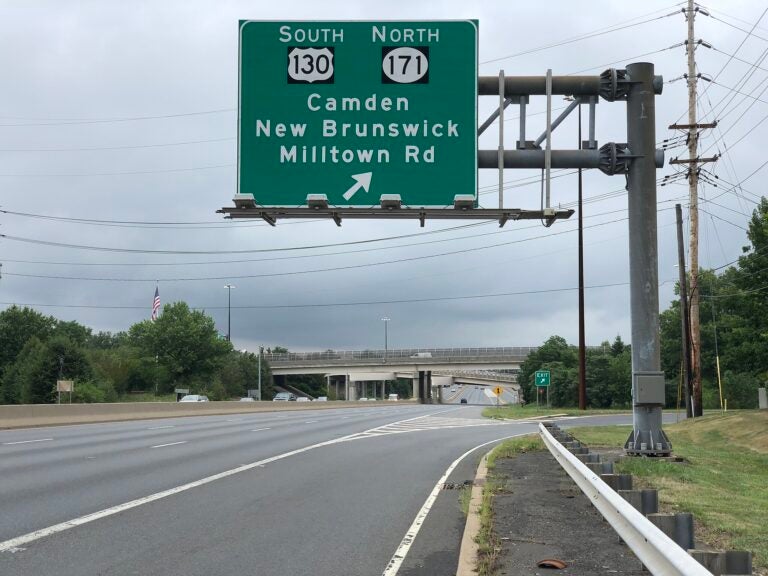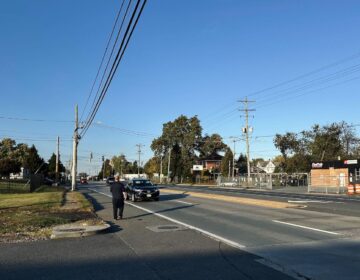New Jersey’s latest congestion relief plan? Drive on the shoulder
The DOT will reduce traffic congestion by expanding driving on the shoulder of a major central Jersey roadway.

A view north along U.S. Route 1 in N.J. (
From Camden and Cherry Hill to Trenton and the Jersey Shore, what about life in New Jersey do you want WHYY News to cover? Let us know.
The Route 1 Congestion Relief Project, already operational along a section of the roadway in Central Jersey, will be expanded next year.
Drivers on a 2-mile stretch of Route 1 between Independence Way and Promenade Boulevard are currently allowed to use the shoulder of the road as a travel lane during morning and afternoon rush hours.
Steve Schapiro, the New Jersey Department of Transportation press manager, said the DOT plans to expand the Congestion Relief Project an additional 5 miles by next summer.
“We’re always looking to see how we can make travel more efficient, how we can reduce congestion and keep traffic flowing, so this is an idea that we can do without having to widen the roadway,” he said.
He explained that Route 1 has many businesses along it, so widening the roadway would only be possible in some areas.
Tracy Noble, a spokesperson for AAA Trip Alliance, said some safety concerns need to be factored into the project.
She said congestion is a significant issue that needs to be addressed, but at the same time, if the shoulder of the road is being used as a travel lane, drivers need to stay extra alert.
“We’ve got a speeding issue throughout the state, we know drivers in New Jersey are driving well above posted speed limits, not only on local roads but also on busier highways,” she said.
She said even if someone is only going 10 miles an hour faster than the speed limit, “when you think about crashing at that increased speed, your car has never been tested at those increased speeds, so it does come into play.”
Schapiro said the cost of the entire project will be around $6 million, which includes repaving sections of the shoulder, roadway re-striping and relocating raised pavement markers, the reflectors in the surface of the road that help delineate the lanes, and installing cameras to monitor traffic.
He said final design work will be completed this winter, and construction will begin sometime in the spring.
“There’s not a lot of work to do but there is some that needs to happen,” he said.”
Once construction is complete, Schapiro said the 6-month pilot project will be launched next summer.
Noble also voiced another concern.
“The side of the road, the shoulder of the road, is often seen as a refuge for disabled motorists, so we need to figure out how that is going to come into play,” she said.
“There are an ample number of businesses that maybe somebody could pull into. But you never know when you’re in an emergency situation just what your options are.”
Schapiro noted cameras that monitor traffic flow would allow the traffic management staff to quickly take the shoulder lane out of service if there is a breakdown, changing the overhead signage that will be installed from a green check to a red X.
In the summer of 2017, a pilot program was launched by the DOT to allow drivers on Route 1 to use the shoulder of the road as a travel lane during morning and afternoon rush hours to help reduce congestion.
“We did see improved travel times, and a reduction of rear-end crashes,” he said.
He noted northbound travel during the morning and after rush hours in the designated shoulder zone improved by approximately 45%, southbound traffic flow improved by roughly 11%, and “overall congestion time decreased by about 20% for an average day.”
He pointed out parts of Route 1 have three lanes, but many sections of the highway go down to two lanes in each direction, which causes bottlenecks and delays.
Schapiro said lanes on Route 1 could occasionally be closed overnight once the restriping work begins in the spring.
He noted using the shoulder of the road as an extra travel lane has become popular in parts of Europe, and it’s starting to catch on in many areas of the U.S.
“The New Jersey Department of Transportation is looking at innovative and cost-effective solutions to improve traffic flow, improve safety, and relieve congestion,” he said.

Get daily updates from WHYY News!
WHYY is your source for fact-based, in-depth journalism and information. As a nonprofit organization, we rely on financial support from readers like you. Please give today.





